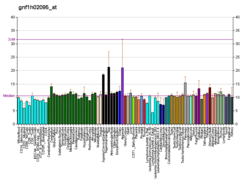Protein-coding gene in the species Homo sapiens
| OR4X1 |
|---|
|
| Identifiers |
|---|
| Aliases | OR4X1, OR11-104, olfactory receptor family 4 subfamily X member 1 (gene/pseudogene), olfactory receptor family 4 subfamily X member 1 |
|---|
| External IDs | HomoloGene: 73447; GeneCards: OR4X1; OMA:OR4X1 - orthologs |
|---|
| Gene location (Human) |
|---|
 | | Chr. | Chromosome 11 (human)[1] |
|---|
| | Band | 11p11.2 | Start | 48,263,861 bp[1] |
|---|
| End | 48,264,778 bp[1] |
|---|
|
| RNA expression pattern |
|---|
| Bgee | |
|---|
| BioGPS |  | | More reference expression data |
|
|---|
|
| Gene ontology |
|---|
| Molecular function | - G protein-coupled receptor activity
- olfactory receptor activity
- transmembrane signaling receptor activity
- signal transducer activity
| | Cellular component | - integral component of membrane
- plasma membrane
- membrane
| | Biological process | - sensory perception of smell
- detection of chemical stimulus involved in sensory perception of smell
- detection of chemical stimulus involved in sensory perception
- signal transduction
- response to stimulus
- G protein-coupled receptor signaling pathway
| | Sources:Amigo / QuickGO |
|
| Orthologs |
|---|
| Species | Human | Mouse |
|---|
| Entrez | | |
|---|
| Ensembl | | |
|---|
| UniProt | | |
|---|
| RefSeq (mRNA) | | |
|---|
| RefSeq (protein) | | |
|---|
| Location (UCSC) | Chr 11: 48.26 – 48.26 Mb | n/a |
|---|
| PubMed search | [2] | n/a |
|---|
|
| Wikidata |
|
Olfactory receptor 4X1 is a protein that in humans is encoded by the OR4X1 gene.[3]
Olfactory receptors interact with odorant molecules in the nose, to initiate a neuronal response that triggers the perception of a smell. The olfactory receptor proteins are members of a large family of G-protein-coupled receptors (GPCR) arising from single-coding exons. Olfactory receptors share a 7-transmembrane domain structure with many neurotransmitter and hormone receptors and are responsible for the recognition and G protein-mediated transduction of odorant signals.[citation needed] The olfactory receptor gene family is the largest in the genome. The nomenclature assigned to the olfactory receptor genes and proteins for this organism is independent of other organisms.[3]
See also
References
- ^ a b c GRCh38: Ensembl release 89: ENSG00000176567 – Ensembl, May 2017
- ^ "Human PubMed Reference:". National Center for Biotechnology Information, U.S. National Library of Medicine.
- ^ a b "Entrez Gene: OR4X1 olfactory receptor, family 4, subfamily X, member 1".
Further reading
- Malnic B, Godfrey PA, Buck LB (2004). "The human olfactory receptor gene family". Proc. Natl. Acad. Sci. U.S.A. 101 (8): 2584–9. Bibcode:2004PNAS..101.2584M. doi:10.1073/pnas.0307882100. PMC 356993. PMID 14983052.
External links
This article incorporates text from the United States National Library of Medicine, which is in the public domain.
Class I
(fish-like receptors) | | Family 51 | |
|---|
| Family 52 | |
|---|
| Family 56 | |
|---|
|
|---|
Class II
(tetrapod specific receptors) | | Family 1 | |
|---|
| Family 2 | |
|---|
| Family 3 | |
|---|
| Family 4 | |
|---|
| Family 5 | |
|---|
| Family 6 | |
|---|
| Family 7 | |
|---|
| Family 8 | |
|---|
| Family 9 | |
|---|
| Family 10 | |
|---|
| Family 11 | |
|---|
| Family 12 | |
|---|
| Family 13 | |
|---|
|
|---|

















